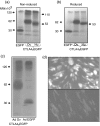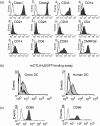Ovine dendritic cells transduced with an adenoviral CTLA4eEGFP fusion protein construct induce hyporesponsiveness to allostimulation
- PMID: 15500617
- PMCID: PMC1782587
- DOI: 10.1111/j.1365-2567.2004.01966.x
Ovine dendritic cells transduced with an adenoviral CTLA4eEGFP fusion protein construct induce hyporesponsiveness to allostimulation
Abstract
CTLA4 (CD152) is a transmembrane molecule expressed on activated T cells and functions as a negative regulator of T cell activation upon binding to the costimulatory molecules CD80/86. In this study, CTLA4eEGFP constructs were engineered by cloning the extracellular domains of ovine and human CTLA4 (CTLA4e) 'in frame' with the enhanced green fluorescent protein (EGFP). Recombinant adenoviral vectors were generated by incorporation of the CTLA4eEGFP sequence into the adenoviral genome using homologous recombination in Esherichia coli. The functional activity of the adenoviral vectors was shown by the secretion of the CTLA4eEGFP upon infection of ovine fibroblasts and the binding of the fusion protein to the target ovine and human dendritic cells expressing CD80/86 receptors by flow cytometry. The EGFP tag facilitated molecular size determinations and quantification of the secreted ovine CTLA4 fusion protein by immunoprecipitation and enzyme-linked immunosorbent assay (ELISA), respectively, using anti-GFP mAbs. Ovine dendritic cells obtained from pseudoafferent lymphatic cannulation of sheep were characterized based on high major histocompatibility complex (MHC) class II expression and cross-reactivity with monoclonal antibodies to the human dendritic cell markers, CD83 and CMRF-56. In addition, ovine dendritic cells (DC) were transfected with the adenoviral CTLA4eEGFP and when used as stimulators in a mixed lymphocyte reaction showed a reduced capacity to induce allogeneic lymphocyte proliferation. This study verifies that the ovine CTLA4eEGFP fusion protein functions similarly to its human homologue and that DC modified with adenoviral CTLA4-EGFP may provide an effective therapeutic approach in targeting alloreactive T cells to prolong allograft acceptance in a preclinical ovine model of renal transplantation.
Figures



Similar articles
-
Transduction with a fiber-modified adenoviral vector is superior to non-viral nucleofection for expressing tumor-associated Ag mucin-1 in human DC.Cytotherapy. 2006;8(1):36-46. doi: 10.1080/14653240500508166. Cytotherapy. 2006. PMID: 16627343
-
Sensitization to enhanced green fluorescence protein minor histocompatibility antigen by gene transduction into dendritic cells and peritoneal exudate macrophages.Transpl Immunol. 2007 Nov;18(2):73-84. doi: 10.1016/j.trim.2007.04.003. Epub 2007 Jun 6. Transpl Immunol. 2007. PMID: 18005848
-
Adenoviral delivery of CTLA4Ig into myeloid dendritic cells promotes their in vitro tolerogenicity and survival in allogeneic recipients.Gene Ther. 1999 Apr;6(4):554-63. doi: 10.1038/sj.gt.3300862. Gene Ther. 1999. PMID: 10476215
-
Poxvirus as a vector to transduce human dendritic cells for immunotherapy: abortive infection but reduced APC function.Gene Ther. 2000 Sep;7(18):1575-83. doi: 10.1038/sj.gt.3301287. Gene Ther. 2000. PMID: 11021596
-
[Changes in immune function of dendritic cells infected by recombinant adenovirus containing Her2/neu gene of extracellular and transmembrane domain proteins].Nan Fang Yi Ke Da Xue Xue Bao. 2006 Aug;26(8):1184-7. Nan Fang Yi Ke Da Xue Xue Bao. 2006. PMID: 16939917 Chinese.
Cited by
-
Immunophenotyping of Sheep Paraffin-Embedded Peripheral Lymph Nodes.Front Immunol. 2018 Dec 11;9:2892. doi: 10.3389/fimmu.2018.02892. eCollection 2018. Front Immunol. 2018. PMID: 30619264 Free PMC article.
-
Natural killer cells prime the responsiveness of autologous CD4+ T cells to CTLA4-Ig and interleukin-10 mediated inhibition in an allogeneic dendritic cell-mixed lymphocyte reaction.Immunology. 2006 Jun;118(2):216-23. doi: 10.1111/j.1365-2567.2006.02359.x. Immunology. 2006. PMID: 16771856 Free PMC article.
-
Characterization of dendritic cells and follicular dendritic cells in the hepatic lymph nodes and liver of sheep experimentally infected with Fasciola hepatica.Vet Res. 2020 Mar 4;51(1):33. doi: 10.1186/s13567-020-00757-1. Vet Res. 2020. PMID: 32131896 Free PMC article.
References
Publication types
MeSH terms
Substances
LinkOut - more resources
Full Text Sources
Research Materials
